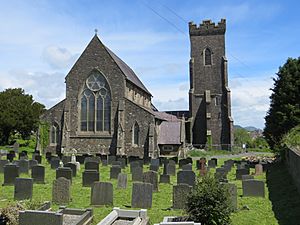St David's Church (Eglwys Dewi Sant), Carmarthen facts for kids
Quick facts for kids Eglwys Dewi Sant |
|
|---|---|
 |
|
| Location | Picton Terrace, Carmarthen |
| Country | Wales, United Kingdom |
| Denomination | Anglican |
| History | |
| Founded | 1835 |
| Architecture | |
| Heritage designation | Grade II |
| Designated | 19 May 1981 |
| Architectural type | Church |
| Style | Early nineteenth century |
| Closed | 2003 |
Eglwys Dewi Sant, also known as St David's Church, was an Anglican church in Carmarthen, Wales. It was built in the 1830s. For a while, people thought it might become a new cathedral. The church became important for Welsh-speaking Anglican people in Carmarthen. It closed in 2003 because the building was no longer safe.
Contents
Early History of St David's Church
Why a New Church Was Needed
In the early 1800s, Carmarthen's population grew a lot. The only Anglican church, St Peter's, became too small. Many people had to go to other churches called nonconformist chapels. To help with this, leaders decided to build a new Anglican church.
At first, the church was planned for Lammas Street and would be called St Paul's. A special stone was laid there in 1824. But the land owner was upset because he wasn't invited to the ceremony. So, he took back his offer of the land.
Building St David's Church
By the mid-1830s, a new spot was found on Picton Terrace in Carmarthen. Another foundation stone was laid in May 1835. The weather was sunny that morning, but a big thunderstorm started during the ceremony. Everyone had to rush to finish the event.
The church was built between 1835 and 1837. Thomas Rowlands built it, following designs by Edward Haycock. The first church services were held on January 19, 1837. Bishop Connop Thirlwall officially opened the church on February 3, 1841. Before the service, the Mayor of Carmarthen and other groups walked in a parade to the new church.
Services and Language
After the church opened, there was a long discussion about the language used in services. Services were held in both Welsh and English. However, a main reason for building the new church was to have more services in Welsh. This was meant to attract people who spoke Welsh and went to other chapels.
This issue was not solved for almost 30 years. Finally, another church, Christ Church, Carmarthen, was built in 1867. This new church was for English-speaking members. This allowed St David's Church to focus on providing services for Welsh-speaking people.
Was it Going to Be a Cathedral?
St David's Church was first a rectangular building with a tower. From 1853 to 1855, a new main part, called a nave, was added. This was built by John James, following designs by Richard Kyrke Penson. The inside of the church was changed, and the altar and organ were moved.
These changes were inspired by David Archard Williams. He hoped this new part would become the nave of a new cathedral. He wanted it to replace the old, worn-out cathedral at St David's. However, Bishop Thirlwall had already started fixing the old cathedral. So, Williams's idea for a new cathedral never happened.
Twentieth Century Changes
The church had a big restoration project in 1912-1913. The large West Window was mostly rebuilt. E.V. Collier did this work. The church reopened with a service in March 1913, attended by the Bishop of St David's.
More changes happened in 1938 by W.E. Anderson. A part of the church called the north transept was removed. The south transept was replaced with a much smaller room called a vestry.
The church was given a special status as a Grade II building on May 19, 1981. This means it is an important old building. It was noted for its tower and how its history showed the growth of the area.
Closure of St David's Church
In November 2003, a storm damaged the church. This damage caused the church to close. In 2011, the building was sold for just £1. People were worried about the church's condition and its graveyard. In 2015, they asked the Church in Wales to take care of the graveyard.
In 2020, permission was given to turn the church building into a climbing center.
The graveyard and the church grounds are now looked after by a charity. This group has worked to restore the grounds and the memorials there. Their website shares the history of important people buried in the graveyard.

